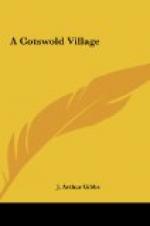Having paid the modest shilling which represents the fare for the five miles, we start off for the priory. There was no difficulty in finding our way to it. In all the Cotswold villages and small towns the “big house” stands out conspicuously among the old cottages and barns and farmhouses, half hidden as it is by the dense foliage of giant elms and beeches and chestnuts and ash; nor is Burford Priory an exception to the rule, though its grounds are guarded by a wall of immense height on one side. And then once more we get the view we have seen so often on Cotswold; yet it never palls upon the senses, but thrills us with its own mysterious charm. Who can ever get tired of the picture presented by a gabled, mediaeval house set in a framework of stately trees, amid whose leafy branches the rooks are cawing and chattering round their ancestral nests, whilst down below the fertilising stream silently fulfils its never-ceasing task, flowing onwards everlastingly, caring nothing for the vicissitudes of our transitory life and the hopes and fears that sway the hearts of successive generations of men?
There the old house stands “silent in the shade”; there are the “nursery windows,” but the “children’s voices” no longer break the silence of the still summer day. Everywhere—in the hall, in the smoking-room, where the empty gun-cases still hang, and in “my lady’s bower,”
“Sorrow and silence
and sadness
Are hanging over
all.”
Until we arrived within a few yards of the front door we had almost forgotten that the place was a ruin; for though the house is but an empty shell, almost as hollow as a skull, the outer walls are absolutely complete and undamaged. At one end is the beautiful old chapel, built by “Speaker” Lenthall in the time of the Commonwealth. There is an air of sanctity about this lovely white freestone temple which no amount of neglect can eradicate. The roof, of fine stucco work, has fallen in; the elder shrubs grow freely through the crevices in the broken pavement under foot,—and yet you feel bound to remove your hat as you enter, for “you are standing on holy ground.”
“EXUE CALCEOS, NAM TERRA EST SANCTA.”
Over the entrance stands boldly forth this solemn inscription, whilst angels, wonderfully carved in white stone, watch and guard the sacred precincts. At the north end of the chapel stands intact the altar, and, strangely enough, the most perfectly preserved remnants of the whole building are two white stone tablets plainly setting forth the Ten Commandments. The sun, as we stood there, was pouring its rays through the graceful mullioned windows, lighting up the delicate carving,—work that is rendered more beautiful than ever by the “tender grace of a day that is dead,”—whilst outside in the deserted garden the birds were singing sweetly. The scene was sadly impressive; one felt as one does when standing by the grave of some old friend. As we passed




